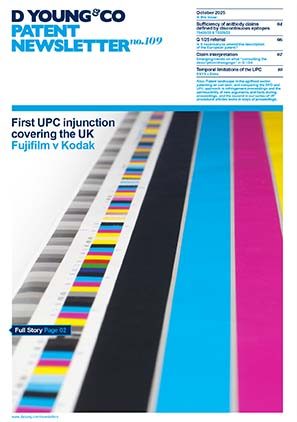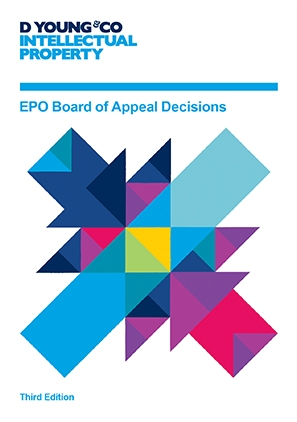G 4/19: double patenting at the European Patent Office
The pending referral G 4/19, from the appeal of T 318/14, seeks answers from the Enlarged Board of Appeal regarding the issue of double patenting at the European Patent Office (EPO). G 4/19 is a referral to the Enlarged Board of Appeal under the provisions of Article 112(1) EPC, where an appeal board may refer a question, or set of questions, to the Enlarged Board of Appeal in order to ensure uniform application of the law (in the event of divergence of the case law) or where a point of law of fundamental importance arises.
As of yet, no decision has been received from the Enlarged Board of Appeal in G 4/19. In this article, we will take a look at both the underlying patent application and the appeal which led to this referral. Furthermore, we look at the current status of the referral and consider what we may learn from the Enlarged Board of Appeal’s decision in G 4/19.
Double patenting
Double patenting in the context of this referral, considers a specific situation where there are two European applications directed to the same subject matter, having the same effective date and being filed by the same applicant (see point 21 of T 318/14). Moreover, the specific situation under consideration requires the two patents, or applications, to claim the same or identical subject matter; merely overlapping claim scope is not considered to be double patenting and is generally allowable at the EPO (see T 877/06 and G 2/10).
In this context, there are three situations where double patenting of the type considered in this referral may arise.
- The first of these situations is where an applicant files two or more European patent applications on the same day, with those European Patent Applications being directed to the same subject matter.
- The second of these situations is through the filing of divisional applications (where an applicant branches off one or more divisional applications from a parent European patent application). Divisional applications share the same effective date as their parent. As such, if the divisional applications are directed to the same subject matter as the parent, there will be double patenting.
- Finally, the third of these situations is through an internal priority claim. This is where a first European patent application directed to certain subject matter is filed and, subsequently, a second European patent application is filed validly claiming priority from the first application. If the second European patent application is directed to the same subject matter as the first application, then there will be double patenting.
In each of these situations, it is noted that the prohibition on double patenting does not prevent the filing of the subsequent application to the same subject matter. Rather, double patenting is considered to prohibit the grant of a second patent to the same subject matter when a first patent to that subject matter has been granted (see point 13.4 of G 1/05 and G 1/06).
T 318/14
T 318/14 is an appeal against the refusal of an application by the examining division on the grounds of double patenting. The written decision to refer questions to the Enlarged Board of Appeal was issued in December 2019.
In the underlying application refused by the examining division, the applicant (Société des Produits Nestlé SA) sought protection for a composition for the treatment of allergic diarrhoea. However, the applicant had already received a granted patent at the EPO for this same subject matter, the granted patent originating from an application from which the application refused by the examining division claimed priority. Accordingly, the double patenting in this case arose by means of an internal priority claim (the third situation above).
Since these two applications shared the same effective date (owing to the priority claim) the later application could not be refused for lack of novelty (because the earlier application, from which priority was claimed, was not citeable as prior art). However, the examining division refused the grant of the later application on the grounds of double patenting.
As legal basis for the refusal, the examining division cited Article 97(2) EPC “in conjunction with Article 125 EPC” (see point 1 of T 318/14). The examining division also referred to previous decisions from the Enlarged Board of Appeal in the form of G 1/05 and G 1/06.
In G1/05 and G1/06, the Enlarged Board of Appeal noted that, “The Board accepts that the principle of prohibition of double patenting exists on the basis that an applicant has no legitimate interest in proceedings leading to the grant of a second patent for the same subject-matter if he already possesses one granted patent therefor” (see point 13.4 of G 1/05 and G 1/06).
In the appeal, the applicant (the appellant) argued that G 1/05 and G 1/06 were limited to the case of double patenting arising in a different situation (that is, from a divisional application) and not from an internal priority claim. Moreover, the appellant argued that it had been acknowledged in T 1423/07 that a legitimate interest exists in the specific situation of double patenting from an internal priority claim. Specifically, double patenting arising from an internal priority claim offers an applicant a 21 year term of protection for certain subject-matter (beyond the maximum 20 year term specified in Article 63(1) EPC for a single patent) as the term of protection is determined based on the date of filing and not the date of priority.
The Board of Appeal considered these arguments in detail in the written decision of referral dated December 2019 (the questions already being announced during the oral proceedings of February 2019). The Board of Appeal noted that the principle of a prohibition on double patenting set out in G 1/05 and G 1/06, while made in the context of answering questions on divisional applications, appeared to apply more generally to double patenting arising by other means, such as from an internal priority claim (see point 11 of T 318/14).
Furthermore, the Board of Appeal acknowledged that, in T 1423/07, it had been held that the longer term of protection possibly available to an applicant, owing to double patenting arising from an internal priority claim, constituted a legitimate interest. However during an analysis of the case law, the Board of Appeal noted that T 2461/10 appeared to raise doubts about the legal consequence of T 1423/07, particularly in view of the wording and intention of Article 63(1) EPC (see point 14 of T 2461/10). As such, in view of the divergence in the case law, the Board of Appeal decided that a decision on the appeal could not be reached until a referral had been made to the Enlarged Board of Appeal (see point 14 and point 15 of T 318/14).
Finally, the Board of Appeal reviewed the legal basis for double patenting in the EPC more generally, and noted that there does not appear to be any express legal basis in the EPC which prohibits double patenting of this kind (see point 78 of T 318/14).
In particular, the Board of Appeal noted that the Guidelines for Examination (G-IV-5.4) appeared to imply that Article 125 EPC provides legal basis for the prohibition on double patenting (with the Guidelines for Examination citing also G 1/05 and G 1/06 in this context). However, in view of an analysis of the case law and the legislative history of Article 125 EPC, the Board of Appeal considered that it was questionable whether Article 125 EPC was appropriate as a legal basis for a prohibition on double patenting. In fact, the Board of Appeal stated that Article 125 EPC could not serve to introduce a new condition for patentability or a ground for refusal (see points 63 and 64 of T 318/14).
Furthermore, on the apparent gap in the EPC regarding double patenting of this kind, the Board of Appeal noted that reasonable doubt existed regarding the legislator’s intention in respect of double patenting and considered that it may be necessary for the Boards of Appeal to refrain from filling any perceived gap in the law in this regard (see point 75 of T 318/14).
Questions of referral
In view of this analysis, the Board of Appeal referred the following questions to the Enlarged Board of Appeal:
“1) Can a European patent application be refused under Article 97(2) EPC if it claims the same subject-matter as a European patent which was granted to the same applicant and does not form part of the state of the art pursuant to Article 54(2) and (3) EPC?”
This first question is really asking whether or not a prohibition on double patenting (of the type considered in this referral) can be maintained in absence of an apparent lack of express legal provision in the EPC.
“2.1) If the answer to the first question is yes, what are the conditions for such a refusal, and are different conditions to be applied depending on whether the European patent application under examination was filed a) on the same date as, or b) as a European divisional application (Article 76(1) EPC) in respect of, or c) claiming the priority (Article 88 EPC) in respect of a European patent application on the basis of which a European patent was granted to the same applicant?”
This second question specifically identifies the three individual types of double patenting situations considered above and also asks whether or not there should be any difference in the treatment of these three types.
“2.2) In particular, in the last of these cases, does an applicant have a legitimate interest in the grant of a patent on the (subsequent) European patent application in view of the fact that the filing date and not the priority date is the relevant date for calculating the term of the European patent under Article 63(1) EPC?”
Finally, this second part to the second question explores the issues most relevant to the case underlying the appeal and, in particular, asks whether the extended term of protection which could be afforded through the third situation of double patenting identified above (the internal priority claim) provides a legitimate interest which justifies the double patenting of the same subject matter by an applicant.
Where are we now?
At present, the referral G 4/19 is pending so we do not have any answer to these questions which have been referred to the Enlarged Board of Appeal. However, there is a notice in the Official Journal of the EPO that proceedings before the examining division and opposition division in which the decision depends entirely on the outcome of G 4/19 will be stayed ex-officio until the Enlarged Board of Appeal issues a decision in G 4/19 (see OJ EPO 2020, A20).
Regarding G 4/19, it will certainly be interesting to see how the Enlarged Board of Appeal answers these questions and addresses the legal analysis provided in T 318/14. In particular, it will be interesting to learn whether or not the Enlarged Board of Appeal considers that a prohibition on double patenting can be maintained in the absence of an apparent lack of express legal provision in the EPC. Furthermore, we hope to receive further clarification on what constitutes a legitimate interest, and whether or not the extended term of protection afforded from double patenting arising from an internal priority claim, provides a legitimate interest which justifies double patenting.
We look forward to receiving further clarification from the Enlarged Board of Appeal on the issue of double patenting at the EPO in due course.


